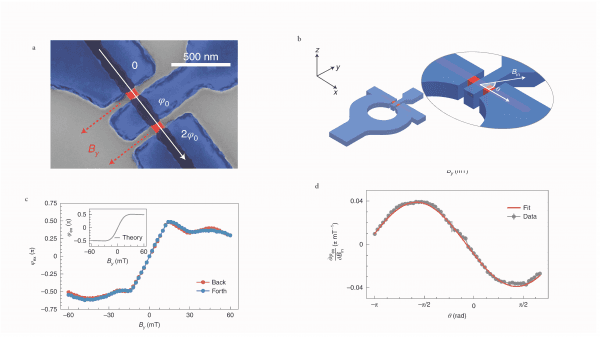A Josephson phase battery
Strambini et al. demonstrate a quantum device that provides a persistent phase bias to a superconducting circuit. It consists of a InAs nanowire proximitized by Al superconducting leads. The ferromagnetic polarization of the unpaired-spin states is efficiently converted into a persistent phase bias across the wire. The observed symmetries in the magnetic field confirm the predictions of the theoretical model previously presented by the authors.
A classical battery converts chemical energy into a persistent voltage bias that can power electronic circuits. We denote a phase battery as a quantum device that provides a persistent phase bias to a quantum circuit’s wave function. It represents a key element for quantum technologies based on phase coherence. In the present work, the authors demonstrate the first implementation of a phase battery in a hybrid superconducting circuit.
The device is shown in figure (a). It consists of an n-doped InAs nanowire (red) with unpaired-spin surface states, proximitized by Al superconducting leads (blue). The authors found that the ferromagnetic polarization of the unpaired-spin states is efficiently converted into a persistent phase bias φ0 across the wire, leading to the anomalous Josephson effect. The phase bias can be controlled by an external magnetic field [figure (b)], achieving a continuous tuning of φ0 [figure (c)]. Hence, it is possible to charge and discharge the quantum phase battery. The observed symmetries of the anomalous Josephson effect in the vectorial magnetic field agree with the theoretical predictions calculated by the authors [figure (d)] in a previous work1,2.
These results demonstrate how the combined action of spin-orbit coupling and exchange interaction induces a strong coupling between charge, spin, and superconducting phase, able to break the phase rigidity of the system. This quantum element, providing a controllable and localized phase bias, can find applications in different quantum circuits such as an energy tuner for superconducting flux and hybrid qubits, or a persistent multi-valued phase-shifter for superconducting quantum memories as well as superconducting rectifiers. Moreover, the magnetic control over the superconducting phase opens new avenues for advanced schemes of topological superconducting electronics based on InAs junctions.

Figure: (a) Scanning electron microscopy image of the active region of the phase battery composed by the two φ0-junctions. By is the in-plane magnetic field orthogonal to the nanowire. (b) Sketch of the interferometer with the reference axes of the in-plane magnetic field (Bin) and the angle θ with respect to the nanowire axis. (c) Dependence of the extrinsic anomalous phase φex on By. It results in an odd symmetry and non-hysteretic back and forth sweeps (blue and red traces). Inset: the φex(By) dependence obtained from our theoretical model. (d) Plot of ∂φex/∂Bin versus θ together with a theoretical fit (red curve).
1 Bergeret FS, and Tokatly IV “Theory of diffusive φ0 Josephson junctions in the presence of spin-orbit coupling” EPL 110, 57005 (2015).
2 Konschelle F, Tokatly IV, and Bergeret FS “Theory of the spin-galvanic effect and the anomalous phase shift φ0 in superconductors and Josephson junctions with intrinsic spin-orbit coupling” Physical Review B 92, 125443 (2015).



